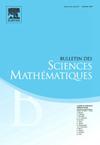Hilbert空间算子交换对的半次反常
IF 0.9
3区 数学
Q2 MATHEMATICS, APPLIED
引用次数: 0
摘要
首先给出了具有可交换项的正2×2算子矩阵的平方根的显式公式,然后用它来定义和研究Hilbert空间算子的可交换对的半次反常。对于众所周知的2变量加权位移的3参数族W(α,β)(a,x,y),我们完全识别了开放单元立方体中W(α,β)(a,x,y)为次正规、次正规、半次正规和弱次正规的参数区域。因此,我们详细描述了每个属性所包含的具体子区域。例如,我们确定弱次反常存在但半次反常不存在的特定子区域,反之亦然。为了实现这一目标,我们采用了一种新的技术,该技术源自于l2 (Z+2)的齐次正交分解。该技术允许我们将半次反常的研究减少到2×2标量矩阵序列的正性考虑。它还需要一个特定的公式来求2×2标量和算子矩阵的平方根,我们在这个过程中得到了它。作为我们主要结果的一个应用,我们证明了Drury-Arveson位移不是半次异常。总的来说,新的结果提供了一个鲜明的对比,上述性质的单边加权位移和他们的2变量对应。本文章由计算机程序翻译,如有差异,请以英文原文为准。
Semi-hyponormality of commuting pairs of Hilbert space operators
We first find an explicit formula for the square root of positive operator matrices with commuting entries, and then use it to define and study semi-hyponormality for commuting pairs of Hilbert space operators. For the well-known 3–parameter family of 2–variable weighted shifts, we completely identify the parametric regions in the open unit cube where is subnormal, hyponormal, semi-hyponormal, and weakly hyponormal. As a result, we describe in detail concrete sub-regions where each property holds. For instance, we identify the specific sub-region where weak hyponormality holds but semi-hyponormality does not hold, and vice versa. To accomplish this, we employ a new technique emanating from the homogeneous orthogonal decomposition of . The technique allows us to reduce the study of semi-hyponormality to positivity considerations of a sequence of scalar matrices. It also requires a specific formula for the square root of scalar and operator matrices, and we obtain that along the way. As an application of our main results, we show that the Drury-Arveson shift is not semi-hyponormal. Taken together, the new results offer a sharp contrast between the above-mentioned properties for unilateral weighted shifts and their 2–variable counterparts.
求助全文
通过发布文献求助,成功后即可免费获取论文全文。
去求助
来源期刊
CiteScore
1.90
自引率
7.70%
发文量
71
审稿时长
6-12 weeks
期刊介绍:
Founded in 1870, by Gaston Darboux, the Bulletin publishes original articles covering all branches of pure mathematics.

 求助内容:
求助内容: 应助结果提醒方式:
应助结果提醒方式:


